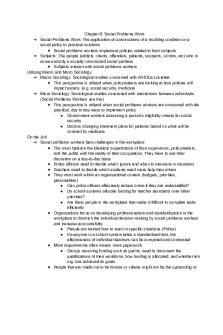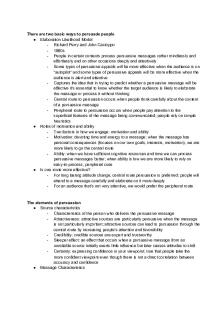Chapter 8 Social Problems Work PDF

| Title | Chapter 8 Social Problems Work |
|---|---|
| Course | Social Problems |
| Institution | University of North Carolina at Charlotte |
| Pages | 3 |
| File Size | 67.5 KB |
| File Type | |
| Total Downloads | 54 |
| Total Views | 165 |
Summary
Chapter 8 Notes....
Description
Chapter 8: Social Problems Work ➔ Social Problems Work: The application of constructions of a troubling condition or a social policy to practical solutions ◆ Social problems workers implement policies related to their subjects ➔ Subjects: The people (addicts, clients, offenders, patients, suspects, victims, etc) who in some embody a socially constructed social problem ◆ Subjects interact with social problems workers Utilizing Macro and Micro Sociology ➔ Macro Sociology: Sociological studies concerned with WHOLE societies. ◆ This perspective is utilized when policymakers are looking at how policies will impact society. (e.g. social security, medicare ➔ Micro Sociology: Sociological studies concerned with interactions between individuals. (Social Problems Workers use this) ◆ This perspective is utilized when social problems workers are concerned with the practical, day to day ways to implement policy ● Government workers assessing a person’s eligibility criteria for social security ● Doctors changing treatment plans for patients based on what will be covered by medicare On the Job ➔ Social problems workers face challenges in the workplace ◆ The must balance the idealistic expectations of their supervisors, policymakers, and the public with the reality of their occupations. They have to use their discretion on a day-to-day basis ◆ Police officers need to decide what t ignore and when to intervene in situations ◆ Teachers need to decide which students need more help than others ◆ They must work within an organizational context (budgets, priorities, personalities) ● Can police officers effectively reduce crime if they are understaffed? ● Do school systems allocate funding for teacher assistants over other priorities? ● Are there people in the workplace that make it difficult to complete tasks efficiently ◆ Organizations focus on developing professionalism and standardization in the workplace to diminish the individual decision-making by social problems workers and increase accountability ● People are trained how to react in specific situations (Police) ● If everyone in a school system takes a standardized test, the effectiveness of individual teachers can be compared and contrasted ◆ More requirements often means more paperwork ● Groups receiving funding such as grants, need to document the qualifications of their workforce, how funding is allocated, and whether teh org. has achieved its goals ◆ People that are made out to be heroes or villains might not be the upstanding or
evil people that claims makers made them out to be ● Someone on welfare who is working hard but struggling might create a sympathetic reaction from a social services worker ○ Counters negative stereotype ● Someone who volunteers to help non-profits but steals from them would receive a negative reaction from people within the org. ○ Counters positive image Constructing Cases ➔ Case: An instance of a previously constructed troubling condition that requires attention through the application of appropriate policy ➔ Social problems workers deal with many subjects (people) who require some sort of attention. They must label subjects and sort them into categories and then address their issues with specific procedures ◆ Criminal or Victim? (category) ◆ Sick or healthy? (category) ◆ Arresting someone if they are a criminal. (procedure) ➔ When assessing individual cases, social problems workers consider the following: ◆ What seems to be the problem? ● Label the condition (flu, assault) ◆ Which aspects of the case are relevant? ● Too many details form the subject decreases efficiency ● Tension when there is a disagreement between worker and subject on what is relevant ◆ Does this seem to be a serious matter? ◆ What is the nature of the subject/person? ● Focus on demeanor, attitude; sometimes more important than demographics (age, gender, race) ◆ Are other people watching? ● How will other people react to the situation or treatment of the subject? ◆ ARe there work-related considerations? ● End of the day ● What is encouraged or discouraged by supervisors? ● What is the caseload? ◆ Social problems workers develop routines to help them deal with cases efficiently. The Subjects view ➔ Subjects tend to view their situation as unique, compared to social problems workers who seem them as a case number ◆ Social problems workers can be viewed as insensitive ➔ Subjects try and convince social problems workers why their behavior is reasonable ◆ Ex: Justifying speeding to an officer ➔ Social problems workers try to get subjects to adopt a new identity and view their behavior as part of a larger troubling condition (drug addict/drug abuse, battered wife/ domestic violence)
◆ Adopting an identity in 12 step programs (e.g. “I am an alcoholic) ➔ Some social problems work is COERCIVE, while other is based on accepting services ◆ Ex. Getting imprisoned vs. seeking out drug counseling ➔ Social problems workers wants subjects to: ◆ Concede that the problems was correctly identified and adopt a new identity ◆ Follow recommendations for treatment ➔ Resistance to following recommendations can be open or private ◆ Open: Tell a doctor you plan to drink as much as you want ◆ Private: Ignore instructions from a doctor to only have one alcoholic drink per day ➔ Social Problems workers can be frustrated by people who: ◆ Insist on alternative interpretations of the situation Looking over their shoulders ➔ Social Problems workers are expected to be productive ◆ Work efficiently, prioritize, and minimize mistakes ➔ Supervisors are accountable to others inside, and outside of their agency ➔ The responses of workers and supervisors to these conditions revolve around TWO central principles: ◆ Try to control info about their activities ● Issue their own reports and control the data others see (highlight positive, hide negative) ● Use public relations specialists to interact with the media ◆ Limit outsiders’ authority over their activities ● People inside the agency might have more empathy or sympathy for what the workers are going through (e.g. teaching and the focus on test scores) ● Subjects with more resources (e.g. middle class and wealthy) receive more oversight than people with less resources ○ Less powerful groups face a “cycle of disappointment” Everyday social problems work ➔ People continually shift the way they treat people as society continues to evolve ◆ Ex- standing up to bullies ➔ People have a hard time connecting the behavior of family and close friends as instances of larger troubling conditions ◆ Ex- a spouse may “like to have some drinks” but is not labeled as an alcoholic ➔ The media helps people reinterpret troubling conditions (Macro/Micro link) ◆ Ex- talk shows help people learn to recognize domestic violence and get people help; shows that chronicle addiction may assist people in recognizing habits in a loved one....
Similar Free PDFs

Chapter 8 Social Problems Work
- 3 Pages

Enrichment Problems-Chapter 8
- 6 Pages

Practice Problems Chapter 8
- 4 Pages

Social Work
- 4 Pages

Social psychology chapter 8
- 6 Pages

Social Problems
- 5 Pages

Chapter 8: Problems of Kinship
- 13 Pages

Social Work Applied Social Science
- 14 Pages

Social Work - Applied Social Science
- 14 Pages

8 - Work
- 1 Pages

SOCIAL GROUP WORK
- 5 Pages

Social Work Principles
- 17 Pages

Introduction to Social Work
- 9 Pages
Popular Institutions
- Tinajero National High School - Annex
- Politeknik Caltex Riau
- Yokohama City University
- SGT University
- University of Al-Qadisiyah
- Divine Word College of Vigan
- Techniek College Rotterdam
- Universidade de Santiago
- Universiti Teknologi MARA Cawangan Johor Kampus Pasir Gudang
- Poltekkes Kemenkes Yogyakarta
- Baguio City National High School
- Colegio san marcos
- preparatoria uno
- Centro de Bachillerato Tecnológico Industrial y de Servicios No. 107
- Dalian Maritime University
- Quang Trung Secondary School
- Colegio Tecnológico en Informática
- Corporación Regional de Educación Superior
- Grupo CEDVA
- Dar Al Uloom University
- Centro de Estudios Preuniversitarios de la Universidad Nacional de Ingeniería
- 上智大学
- Aakash International School, Nuna Majara
- San Felipe Neri Catholic School
- Kang Chiao International School - New Taipei City
- Misamis Occidental National High School
- Institución Educativa Escuela Normal Juan Ladrilleros
- Kolehiyo ng Pantukan
- Batanes State College
- Instituto Continental
- Sekolah Menengah Kejuruan Kesehatan Kaltara (Tarakan)
- Colegio de La Inmaculada Concepcion - Cebu


